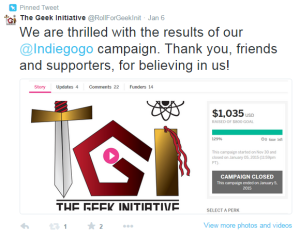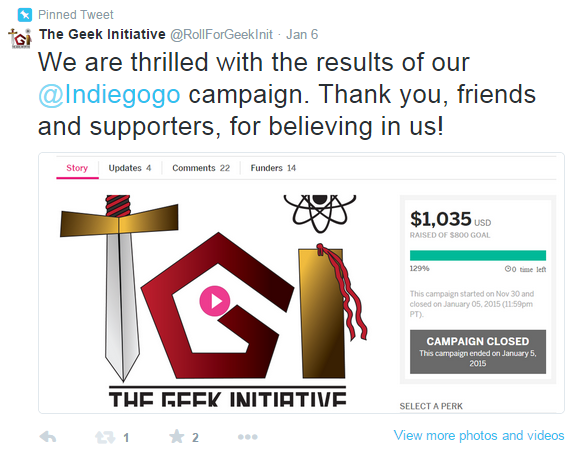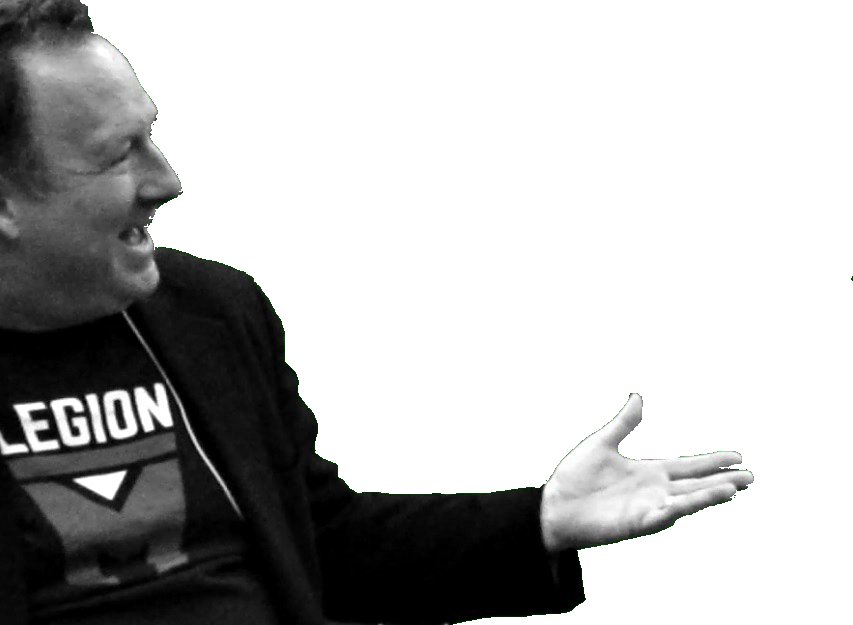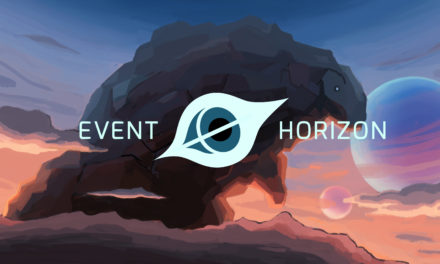The Geek Initiative recently raised over a thousand dollars via Indiegogo. It’s definitely something I recommend if you have the time to commit to it, a community base, and a proven record of success in your field. A few friends and acquaintances, especially in the comic book community, have expressed interest in crowdfunding – and my biggest advice is to get ahead with your work before you crowdfund. You will not have the usual hours in the day to focus on the project itself or additional creative pursuits; it’s all about the campaign.
Three basic tips, especially for creatives:
If you plan to release art, videos, new perks, or project details, you’ll actually want to write, illustrate, and record all of that before you begin your campaign because once you start, your effort will be focused on promotion. This is especially difficult for us creative types, because we’re so jazzed about our projects and we are naturally inclined to create material every day.
You need to realize that a significant portion of your job needs to be spent on forming connections, networking, and promoting while you are running an Indiegogo. It’s not enough to have a good reputation. Even if you’re moderately famous, you need to spend time on promotion.
Take time to research each crowdfunding option. Indiegogo worked well for me because of its flexible funding option. You need to find out what works best for you and then commit to it. Indiegogo reached out to me a few days after campaign creation and a representative from my category even evaluated the campaign and discussed it with me on the phone. This made me feel like Indiegogo valued our success and I will definitely use it in the future for any project requiring crowdfunding in the campaign model (versus subscription).
My biggest challenges:
 Crowdfunding is its own job. When I interviewed Maya Glick about her Storm fanfilm and its Kickstarter, she explained that crowdfunding is a job. I quickly found out that she was right. I was NOT prepared – for part of our campaign, I worked two full-time jobs with a strenuous commute. On top of that, I was still keeping this site active, posting crowdfunding updates, and more. At times I questioned myself for doing the crowdfunding, but at the end of the day, the website is my baby, and everyone knows that babies don’t always let you sleep.
Crowdfunding is its own job. When I interviewed Maya Glick about her Storm fanfilm and its Kickstarter, she explained that crowdfunding is a job. I quickly found out that she was right. I was NOT prepared – for part of our campaign, I worked two full-time jobs with a strenuous commute. On top of that, I was still keeping this site active, posting crowdfunding updates, and more. At times I questioned myself for doing the crowdfunding, but at the end of the day, the website is my baby, and everyone knows that babies don’t always let you sleep.
Once I sucked it up, I was able to maintain a positive attitude through the campaign. If you don’t have time to do it, make sure you have a team committed to helping you. Your whole team needs to be on board – and that includes promotion.
Selling it without spamming it. I’ve been writing and promoting content for over a decade, so I’m pretty well-versed in when it’s appropriate to post something and when it’s not. I err on the side of not posting when I’m unsure (or I check with a forum/group moderator), but after a while it becomes difficult when you feel like you’ve exhausted your resources. I learned late in the game to just become generally insistent about asking personal contacts to share the link. I felt most comfortable doing that on Facebook posts rather than directed at individuals.
Asking people directly. I had a hell of a time asking people for money directly. No matter how much I believe in this site, its mission, and the talent of those who contribute, it’s hard to ask for people to hand over cash. It’s a fear of rejection – like when someone says no, it’s a personal judgment of my work. That’s easy to get past when you’re sending something in to a publisher (from my perspective), but terrifying to ask someone to invest in your idea.
Ultimately, I overcame this by asking for link sharing more than financial contributions. People appreciated that much more than being put on the spot, and I felt a lot more comfortable asking. Sometimes when I asked generally for link shares, it resulted in donations and I felt good about it. I hadn’t pressured someone and I knew they really believed in this project.
At the end of the day – it’s me. I have an awesome and committed team, but when it comes down to creating and promoting the campaign, one person has to head it up and take responsibility for success or failure. In our case, that was me. That means I can’t blame someone else for not doing a part. If I saw a lack of promotion or encouragement in one area, I did what I could to fix it myself instead of creating hassle and chaos on my team.
It’s also scary. It’s easy to say ‘my team made this a success,’ but if it had failed, I would have said ‘I failed my team.’ And it would have felt that way.
The mid-campaign slump. This is something people face in all sorts of campaigns – probably even political ones. Halfway through, we faced a slow-down. It was Christmas, I was on vacation, and people just weren’t in front of their computers. We were stuck at 42% until the last 28 hours, when we received our largest donation (anonymous) which was followed by several more financially significant donations.
Believing I deserve it. There are a ton of people out there asking for money, scamming, and constantly begging for sketchy causes that the real stuff sometimes gets buried. Sometimes I felt like I didn’t have a right to raise money for a website that tackles first-world problems when there are families struggling to eat. Despite the fact that I spend a lot of time working on the site, I still have a hard time paying myself, and I need to get over that attitude. I feel guilty if I pay myself for the work and then spend it on media, for example, even if it’s a comic book I’m reviewing.
I’m sure most writers and artists can relate to this struggle because our work is commonly undervalued…but what kills me more than asking for money is not having money to pay my staff, because their content IS worth something whether they are beginners or seasoned pros.
I didn’t have a specific product to stick in the mail to our supporters. Lots of successful campaigns have products they are funding, and that’s what they can offer as a reward. Things like a digital copy of a finished graphic novel or a custom miniature. While I had the advantage of a brand that was already created and a community to support it, I was asking for upgrade and improvement money, not to produce something physical to send in the mail.
Next time I run a campaign, I hope it will include a final product such as a published collection of our work.
Few contributors are truly random. I spent a lot of time reaching out to random people who I thought might care. And while random people can and will donate, it’s important to spend more time on the community that you’re serving. They’re the ones who will support you. Our funding came from a variety of supporters including the LARP community, comic book shops, and the friends and family members of our contributors.
The website sells itself to these communities, because they believe that creative professionals and their work are worth something.
My biggest surprises and rewards:
The readers I didn’t know we had. I received contributions from people I knew or knew of; I just didn’t realize they were regular readers. It was cool to find out who was reading the site! Our largest donor was anonymous (Indiegogo reveals the name to the campaign administrator) and falls into this category.
Self-doubt. I began and ended this campaign believing in what I was doing, but man…when you go into one of these campaigns, you have to do it that way. Self-doubt kicks in when you hit a slump because when you see that you actually aren’t getting donations, it can mess with your vision and your self-worth. In this way, those who shared the link (even if they couldn’t donate) and cheered us on were the ones who really helped.
It’s hard to find donors but it’s easy to find helpers. Over on Indiegogo, you get the ‘GoGo Factor,’ meaning your campaign is more visible based on how often it is shared or receives donations. Promotion takes a huge effort, but fortunately I found that it was easy to get help when it came to that. When it’s as simple as sharing a link to something someone believes in, they’ll often do it.
Messages like ‘if you believe in our mission, please share our campaign link’ and ‘if you enjoy learning about women in geek culture, please spread the word about our Indiegogo campaign’ did pretty well and got us some shares.
An easy way to get more exposure (increase in GoGo Factor) but not necessarily more donations is to tag your tweets #crowdfunding and #Indiegogo, #Kickstarter, #Patreon, etc.
I also got pretty good at recognizing my weaknesses and what slowed me down – for example, video editing. In those instances, I just posted Facebook messages to ask for help and found that people were more than willing to donate their time. (Thanks to Maya AKA Ask Kaylee Frye for editing our video on short notice.)
The community supports worthy efforts. My first donor was one of our contributors; that meant a lot, because she was really investing in the site’s mission and showing us all that she truly believed in what we were doing. My first large donation was from the LARP community – and interestingly enough, just after our campaign closed, there came a huge discussion about women and LARPing in a popular LARP Facebook group. Men are recognizing the disparity and now they are asking why – and that’s an important piece of the conversation. Having LARP community support reinforces the importance of representing women in geek culture and that means I don’t have to second guess what we’re doing here.
Personal promotion was most effective. Yeah, you shouldn’t oversaturate on your brand’s page – but on your personal page, you might get a lot more positive response. Towards the end of the campaign I was posting daily, and one friend informed me he hadn’t even known about it until then. Facebook’s algorithm will work against you, so utilize ALL social networks and make sure you stay engaged with everyone who responds.
When people see you need help and they also need something, they barter. This got me out of a few jams, including technical difficulties while fundraising.
Advertising space to a target audience is worth more than I thought it was. I was using just Google ads on my site, and now I realize that’s a poor idea. The site’s income will be more sustainable if I sell static ads directly to people who want to reach our demographic. Ad space was an enticing option for some donors.
What I should have done better:
- Be more active on more social networks.
- Solicit my first few donations prior to the start of the campaign. Looking at a $0 for a few hours was really damn scary.
- Plan stretch goals. The last few hundred came in pretty fast and I didn’t have anything planned because just a day and a half earlier, we were not even halfway to our goal.
- Publicly thank public donors on social media networks once they donated. (We will have a thank you page and video up on the site soon.)
- Ended the campaign a few days later. Running it over the holiday was a bad idea.
- Scheduled more content ahead of time. I mean, this is the story of my life as an editor…but usually my workflow is manageable. While running the campaign, it was not.
- Asked for more help, asked for more help, and asked for more help. I should have come up with more specific ways for my team to help as well. In particular, I should have left the entire editorial responsibility of the website in the capable hands of the editorial team.
Do you have questions or tips? Please leave a comment below.





